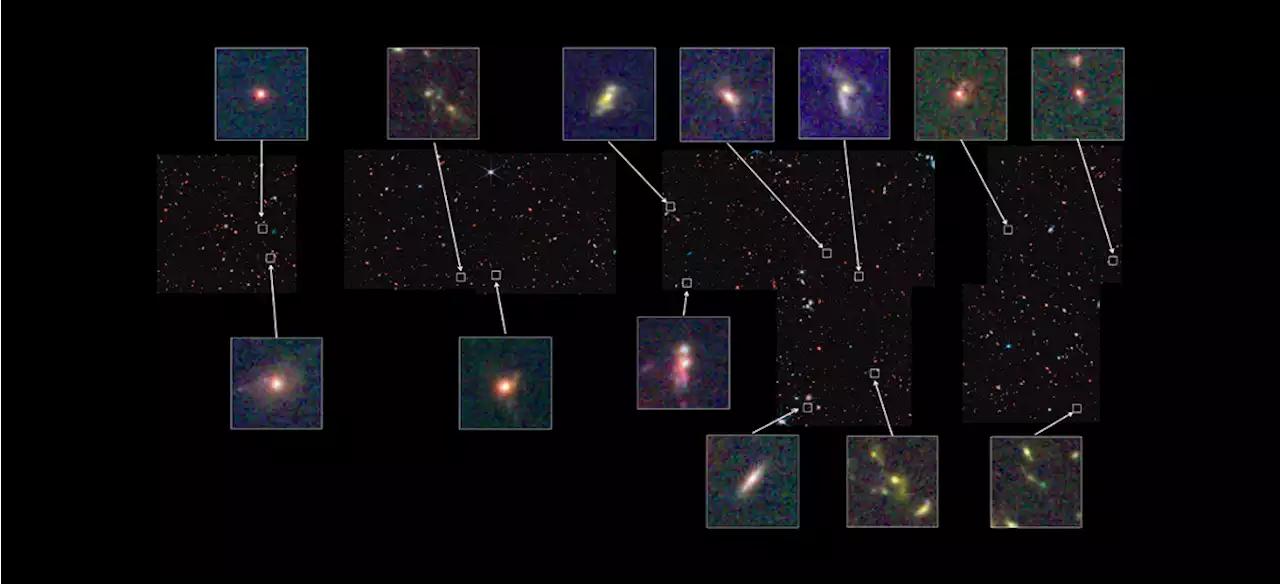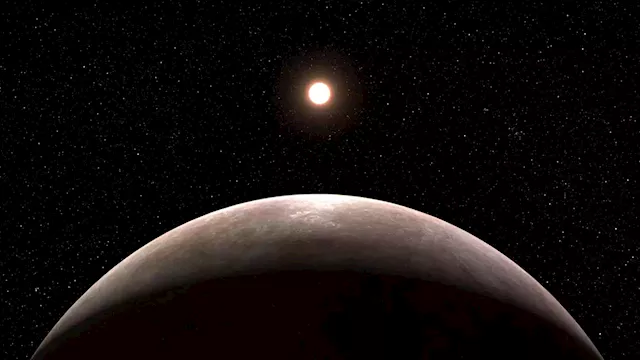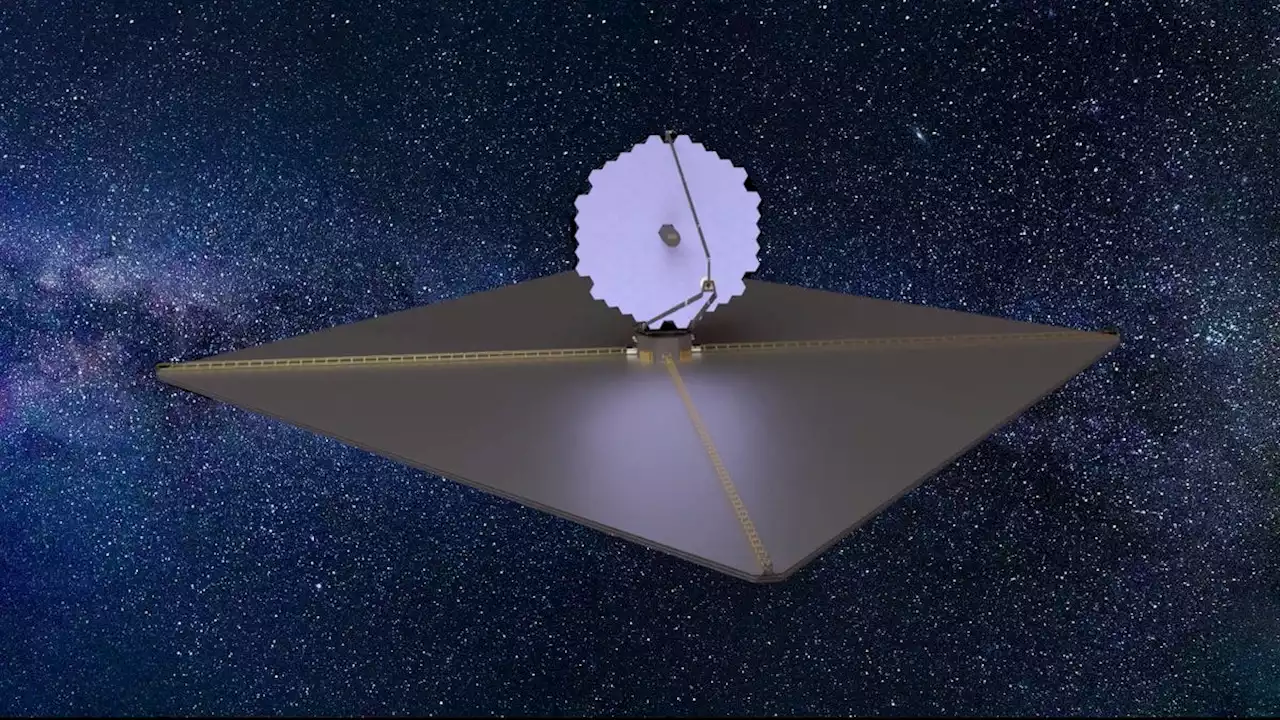Results will aid in future searches for giant planets in wide orbits Not so very far away in cosmic terms, the dusty leftovers of planet formation surround the red dwarf star AU Mic. Caused by smash-ups of small, solid objects called planetesimals, these remnants encircle the small star in an enorm
These two images are of the dusty debris disk around AU Mic, a red dwarf star located 32 light-years away in the southern constellation Microscopium. The team used Webb’s Near-Infrared Camera to study AU Mic. NIRCam’s coronagraph, which blocked the intense light of the central star, allowed the team to study the region very close to the star. The location of the star, which is masked out, is marked by a white, graphical representation at the center of each image.
Credit: Science: NASA, ESA, CSA, Kellen Lawson , Joshua E. Schlieder , Image Processing: Alyssa Pagan Not so very far away in cosmic terms, the dusty leftovers of planet formation surround the red dwarf star AU Mic. Caused by smash-ups of small, solid objects called planetesimals, these remnants encircle the small star in an enormous debris disk.
The north and east compass arrows show the orientation of the image on the sky. Note that the relationship between north and east on the sky is flipped relative to direction arrows on a map of the ground . Credit: Science: NASA, ESA, CSA, Kellen Lawson , Joshua E. Schlieder , Image Processing: Alyssa Pagan has imaged the inner workings of a dusty disk surrounding a nearby red dwarf star. These observations represent the first time the previously known disk has been imaged at these infrared wavelengths of light. They also provide clues to the composition of the disk.
The team used Webb’s Near-Infrared Camera to study AU Mic. With the help of NIRCam’s coronagraph, which blocks the intense light of the central star, they were able to study the region very close to the star. The NIRCam images allowed the researchers to trace the disk as close to the star as 5 astronomical units – the equivalent of“Our first look at the data far exceeded expectations. It was more detailed than we expected. It was brighter than we expected.
Malaysia Latest News, Malaysia Headlines
Similar News:You can also read news stories similar to this one that we have collected from other news sources.
 Galaxies in early universe were surprisingly diverse, James Webb Space Telescope findsEven early on, 'galaxies were already fairly evolved and had a wide range of structures.'
Galaxies in early universe were surprisingly diverse, James Webb Space Telescope findsEven early on, 'galaxies were already fairly evolved and had a wide range of structures.'
Read more »
 Webb Space Telescope finds new planetA University of Arizona researcher is part of the team that used the powerful new James Webb Space Telescope or JWST to find a new planet.
Webb Space Telescope finds new planetA University of Arizona researcher is part of the team that used the powerful new James Webb Space Telescope or JWST to find a new planet.
Read more »
 A New Frontier: NASA’s Webb Space Telescope Confirms Existence of Earth-Sized Rocky Exoplanet!The planet is rocky and almost precisely the same size as Earth, but whips around its star in only two days. Researchers using NASA’s James Webb Space Telescope have formally embarked on a new frontier: Identifying and analyzing rocky exoplanets that orbit red dwarf stars. A team led by Kevin Steve
A New Frontier: NASA’s Webb Space Telescope Confirms Existence of Earth-Sized Rocky Exoplanet!The planet is rocky and almost precisely the same size as Earth, but whips around its star in only two days. Researchers using NASA’s James Webb Space Telescope have formally embarked on a new frontier: Identifying and analyzing rocky exoplanets that orbit red dwarf stars. A team led by Kevin Steve
Read more »
 James Webb Space Telescope uncovers starbirth clues at 'cosmic noon' for 33,000 young starsUsing the James Webb Space Telescope, astronomers have gotten close to understanding how early stars formed during cosmic noon, more than 10 billion years ago.
James Webb Space Telescope uncovers starbirth clues at 'cosmic noon' for 33,000 young starsUsing the James Webb Space Telescope, astronomers have gotten close to understanding how early stars formed during cosmic noon, more than 10 billion years ago.
Read more »
 NASA Reveals Tantalizing Details About Webb Telescope’s SuccessorThe Habitable Worlds Observatory now has a name, a rough timeline, and a whole lot of hype.
NASA Reveals Tantalizing Details About Webb Telescope’s SuccessorThe Habitable Worlds Observatory now has a name, a rough timeline, and a whole lot of hype.
Read more »
 Two Point Campus brings gamers to space with Space Academy DLCSpace Academy, the new DLC for Two Point Campus, is available now for $9.99 on multiple platforms.
Two Point Campus brings gamers to space with Space Academy DLCSpace Academy, the new DLC for Two Point Campus, is available now for $9.99 on multiple platforms.
Read more »
